ANCIENT ROMAN SITES AROUND THE BAY OF NAPLES
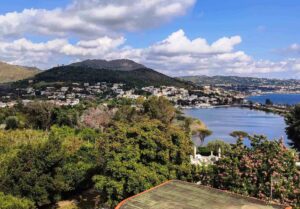
We had long been curious about the Bay of Naples area to the west of Naples. Although knowing the region’s ancient history, we had no idea whether there was anything to see nowadays. Whether there were any significant archaeological sites, or was it going to turn out to be just a pile of old stones in the corner of a paddock, covered in straggly weeds. We had visited Pompeii numerous times over the years, as well as having explored Herculaneum, and with relatively limited time we decided not to re-visit those, but to explore what else there is to see by way of remains of the ancient world. What we discovered were some of the largest, most fascinating archaeological sites in Italy, and although all are “ruins”, they’re well looked-after and presented, and generally very accessible. The area we set out to explore is collectively known as the Phlegraean Fields, location of probably the most overlooked ancient sites in the entire country.
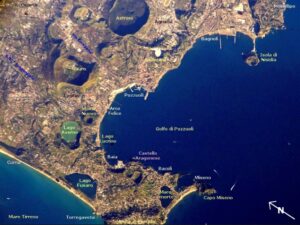
The term Phlegraean Fields comes from the Greek ‘Phlegraios’, meaning “burning fields.” The reference is not only to the volcanic nature of the area, but also to ancient myths, in particular Virgil’s ‘Aeneid’, that identified the region’s Lake Avernus as the gateway to the Underworld. It also referenced the fiery projectiles of the volcanic craters, the boulders, thrown by the legendary man-eating giants to sink Ulysses’ ship. This lake is a little further west of Pozzuoli.
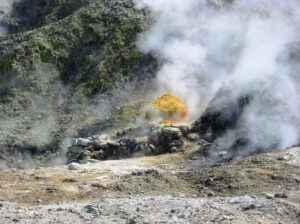
The area is home to a number of important archaeological sites, coastal lakes, beaches, thermal springs and nature reserves, and is well worth a couple of days’ exploration. It’s best to visit in spring or autumn, as the area is an active thermal and volcanic region, so can be uncomfortably hot in the summer months. In the winter, many restaurants and other businesses close for the season.
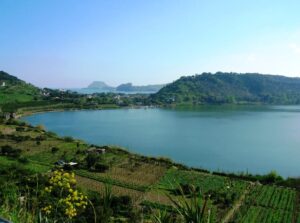
Pozzuoli (ancient Potuoli) is the most important town in the Phlegreaen Fields, and is easy to reach, being just 20 kms from Naples. No less than 8 lakes (5 of which have survived), stretched along the coastline, and be sure to stop at Lake Avernus, mentioned above, a small lake inside an extinct volcano located between the towns of Cumae and Lucrino.
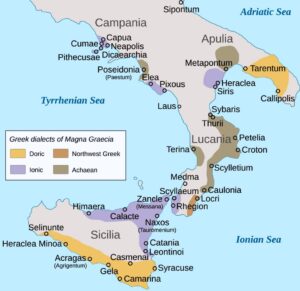
Pozzuoli began as a Greek colony named Dicaearchia, founded around 531 BCE in what was Magna Graecia, with the consent of nearby Cumae when refugees from Samos escaped from the tyranny of Polycrates. The Samnites then occupied and expanded Dicaearchia after conquering Cumae in 421 BCE. It enjoyed considerable commercial autonomy which was helped by the excellent position of its port with the Campanian hinterland. The Romans occupied Campania after the end of the 1st Samnite War from 341 BCE, which marked the start of the Romanisation of the Greek-Samnite city.
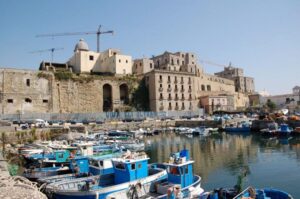
During the Second Punic War (218-201 BCE), Rome reinforced the port’s defences and introduced a garrison to protect the town from Hannibal. It officially became a Roman colony from 195 BCE. Rome recognised that it needed a port for trade, and it became the Mediterranean port for Rome, despite being about 240 kms away. The Roman name “Puteoli” derives from the Latin puteo ”to stink”, referring to the sulfuric fumes in the area, which we occasionally noticed.
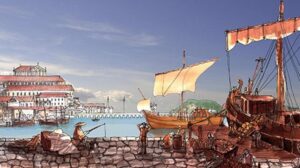
Puteoli became the great trading port for fine fabrics from Asia, spices and perfumes from Arabia, timber and slaves from Africa, honey and fish sauce from Spain, but above all, Alexandrian grain ships. Other trading vessels carried goods being exported from Campania such as blown glass, mosaics, wrought iron and marble. The Roman writer Lucilius wrote in 125 BCE that Putuoli was second only to Delos in importance, then the greatest harbour of the ancient world.
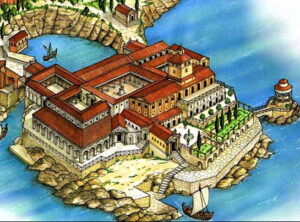
This area became the holiday resort location for the Roman elite wishing to escape the pressures of Rome and enjoy all the benefits of a stunning, coastal getaway. The Roman writer and politician Cicero had a house in Puteoli, and the Roman Dictator Sulla had a country villa there. Pliny mentions that there was a famous cochlearium there owned by Fulvius Hirpinus, who was known for raising highly prized snails, regarded as a great delicacy by the Romans. The local volcanic sand, pozzolana, was the basis for Roman concrete, which reacted chemically with water, turning the sand/lime mix into a mortar strong enough to bind lumps of aggregate into a load-bearing structure. This made it possible to construct the cupola of Rome’s Pantheon, which is still the world’s largest unreinforced concrete dome.
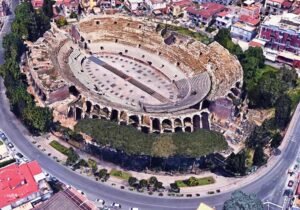
One of the unmissable sights near the coast at Pozzuoli is the enormous elliptical Roman amphitheatre. Although referred to as Flavian, its construction was most likely started by Nero, who was a frequent visitor to the area. It was completed during the reign of either Vespasian or his son Titus. It’s the 3rd largest amphitheatre in Italy, after the Coliseum and the one in Capua, and once accommodated over 50,000 spectators. The interior is mostly intact, and one can still see parts of the gear system, which was used to lift cages up to the arena floor. The structure’s exterior was once clad in marble, but this was stripped during the Middle Ages, although the interior was left alone.
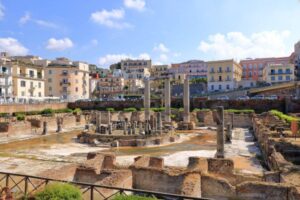
Nearby, close to the waterfront, is the Temple of Serapis, so called because on its discovery in 1750 it was identified as a place of worship of the Egyptian god Serapis. It was not until 1907 that the structure was recognised for what it was: the Macellum, the main market of ancient Puteoli. The rooms that follow one another in regular intervals around the complex, rather than spaces for cult activities, turned out to be ‘tabernae’, that is, shops for commercial activities and the sale of meat and fish. In the centre of the large square stood a small, circular temple, surrounded by 16 columns, with its own fountain and richly decorated niches, housing statues of the market’s patron deities in addition to that of the god Serapis among others. A number of these statues are now in the outstanding Naples Archaeological Museum.
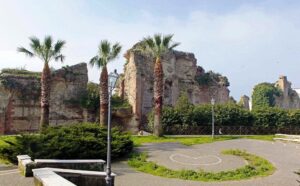
A few blocks away is a most impressive ruin, the Temple of Neptune, which was once a huge thermal baths complex, dating from the 2nd century CE.
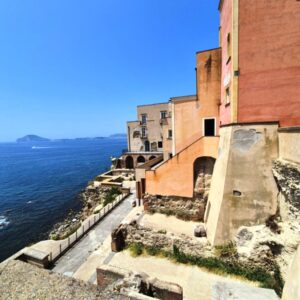
Perhaps the most surprising sight we encountered in Pozzuoli was in the area called Rione Terra, which is the clifftop overlooking the port and bay. This is where the Greeks from Samos founded Dicearchia, and where the Romans built the defences against Hannibal. Magnificent temples were built in the Augustan age, and after the decline of Puteoli in the Middle Ages, families of fishermen took refuge from raiding Saracens and the phenomenon of ‘bradyseism’. This is the slow ground movement, alternating between periods of gradual uplift and more rapid subsidence of the earth’s crust, often accompanied by seismic activity.
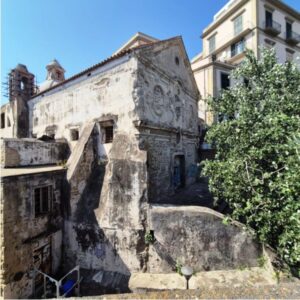
As well as poor housing conditions, it was bradyseism that ultimately drove out the population in 1970, when this phenomenon caused the ground to rise by a couple of centimetres every day. Since then, the district became a ghost town until 2014 when extensive restoration and renovation took place. The site once again became open to visitors, thanks to an extraordinary archaeological itinerary.
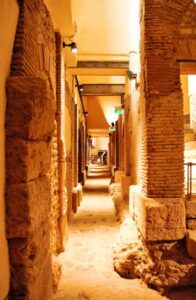
The narrow streets are the legacy of Graeco-Roman urban layout, which gives an idea of how cramped the spaces for housing and daily life were. The area is in fact a rock surrounded on 3 sides by the sea, with a total area of less than 3 hectares. Excavations have not unearthed patrician villas or important dwellings, but rather, warehouses, shops and tavernas alongside large, richly decorated public buildings. Underneath Rione Terra there is a section of underground city, that is, the ancient Roman Puteoli, built all around the religious area, the main building being the Temple of Augustus.
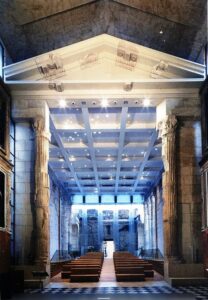
This magnificent ancient building has been brilliantly incorporated into the modern Basilica of San Procolo Martire, the cathedral of Pozzuoli. Rather than demolish the ancient temple, instead, the modern structure had included it as part of the cathedral building. At the end of the 5th century CE the inhabitants of the town decided to rededicate the temple as a church to Proculus of Pozzuoli. In 1538 it suffered major damage through subsidence, and a chapel adjacent to it was constructed.
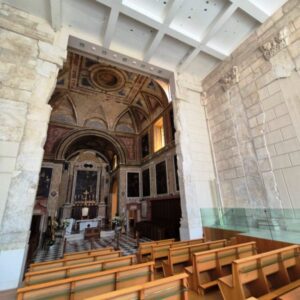
The cathedral was rebuilt in 1632 under the Spanish viceroyalty, and the interior enriched with paintings by famous artists. Because of the fame of these artists, among the greatest of the Neapolitan Baroque, the cathedral was described as one of the finest and most selective galleries of the 17th century. The building incorporated the earlier Christian building from the 5th century as well as the ancient pagan temple—so successfully, that the temple was no longer easily visible, and largely forgotten about during the ensuing centuries.

Disaster struck on 16th May 1964, when the Baroque cathedral was largely destroyed by fire, along with many paintings and an extraordinary artistic memory. It broke out in the upper regions of the wooden ceiling which covered the vaulted ceiling. However, the ravaging flames crumbled to ashes the brittle tufa stone that had covered the carved columns of the Roman Temple. Exposed after the fire were the scattered remnants of the imposing Temple of Augustus ancient building, made of precious marble, that had been incorporated into the church.

The entrance is now through the remains of the façade and first two chapels of the Baroque cathedral, which are now presented as an uncovered narthex in front of the new glass façade which is engraved with the outlines of the destroyed the front row of columns of the ancient portico. The temple floor has been raised back to its original level, which has created space to display the archaeological remains of the Roman temple’s podium in the basement. The whole result is elegant, bright and airy and totally respectful of the ancient past of whole building.
There is so much to see in this region, that I’ll look at more surprising discoveries in the next blog stories.
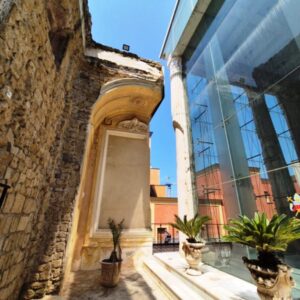


Leave a Reply